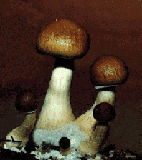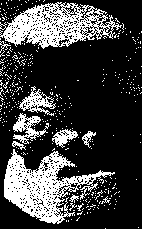SHAMANISM
Entheogens
THE REVIVAL OF SHAMANISM
|
In the future, the spirit of the redskin man, who respects all that is alive with love and veneration, will seize your children and will penetrate in those that do not know anything about him.
Seattle, Dawnish chief. North-west of the USA, 1855
|
The revival of shamanism is not only the fruit of the psychedelic, hippie or New Age movement. Inspired by the
re-enchantment of the world to which the advanced science is an invitation, it was initiated by scientists and bears the
mark of their cartesian method that leads at first to study separately each element of an observed phenomenon.
Biologists were interested in the effects of the psychotropic substances. Ethnologists decided to explore the states of
consciousness to which the shamanism appeal. Therapists wanted to adjoin to the modern medicine a step inspired by
the shamanic practices. All met the dream on their way. A synthesis takes shape today which is directly inspired by it.
First reunion : Maria Sabina and her "sacred children."
It's in the course of their honey moon strolls that the Wasson couple suddenly matched how divided them the vision... of simple mushrooms ! She found them everywhere, he didn't see anyone. To Valentina, whose origin is Russian, they were a Godsend, worthy to appear in all feast meal. Like a good Anglo-Saxon, her husband considered them rather as little dirty things, poisonous and smelling rotten. He would never hit upon the idea of eating them. Intrigued by this difference, they decided to study the place of the mushroom in the history of civilisations and founded a short time after a new discipline, the ethno-mycology, that led them to study the shamanic use of the hallucinogenic mushrooms.
In 1956, they met in Mexico Maria Sabina, Mazatec woman healer about 60 years old. To the Mazatec, the mushrooms were sacred, and their cult represented the only vestige of their destroyed culture. They call them «little that grow», little saints, sacred children and wise men those that use them to cure. Nevertheless, if Maria Sabina had began eating them since the age of six, it was because they cut her hunger and made her merry. Married at fourteen years old, widow at twenty, she became wise by a short coincidence, when her sister implored to try to cure her. During the session, Maria had her first vision. Some «Main beings», about which spoke her ancestors, appeared to her, similar to human beings but «inspiring respect». They presented her a great book, the «Book of Wisdom», and though she was illiterate she red it at loud voice. «Wisdom is the Language. The Language is in the book. The book, it is the Main Beings that award it. The Mains appear thanks to the great power of the sacred children.»
Then she met the Lord of the mountains, bewitcher of the spirits, supreme and faceless healer, riding on his white
horse. Then a luminous object stamped the floor in a thunderous noise, transformed itself into a vegetal being with a
body made of varied coloured flowers, with limbs like branches, all covered with dew. Maria perspired a cold sweat, cried
tears that seemed solid to her. In the morning she fell asleep, «rocked in a dream, as if her body was softly swinging in a
giant hammock hanging on the sky and that oscillated from a mountain to another.» These visions hallowed her as a shaman.
Gradually, she became a recognised Wise woman, even the doctor sent her some patients, to whom she always asked
«what was your dream ?» before to make out a diagnosis and share with them the curative mushrooms. The mayor
invited her to find in her visions the solutions to the village conflicts, and introduced the Wassons to her that she
initiated to the sacred mushrooms. Hallucinated meeting between the new world and the ancient knowledge, on the
field of the magical dreaming !
If the visions of the Wassons were not composed of mythic beings, substituted by geometric patterns or some majestic
landscapes, they were giving the same effect, «loaded with meaning (...) completely above everything that is supposed to
be the world reality. (...) «We felt ourselves facing the "Ideas" about which spoke Plato (...). Balanced in space, I was an
eye separated from its being, invisible, incorporeal, who saw without being seen», wrote Wasson in his articles that, with
the recordings of the songs of Maria Sabina, made her famous and aroused the interest of the scientists.
The research missions then followed one another in the sierra mazatec, leading to the isolation of the active principle of the mushrooms : psilocybin. On their footsteps, the hippies rushed. Maria did not understand that one could research visions of the hallucinogenic dream when one is healthy, but since they were «searching God», she was ready to help. The success turned her head a little, but how not to take advantage of it to go out of the misery that she knew all her life ?
Nevertheless she felt that this infatuation ended the loss of the cultural identity of her people. «They take sacred children
anytime and anywhere. They do not make it at night neither following the indications of the Wise men. The sacred
children lost their purity, their strength, one have wasted them. In future they will not make any effect. Nobody can do
anything», she said just before her death. And later, it is another old wise man that gives the review : «The sacred
mushroom does not belong to us anymore. Its sacred language has been profaned, it became indecipherable to us. Now
the mushrooms speak English !»
From the dream of the shaman her song only was left :
I am a woman who looks inside, says the sacred child
I am a woman of light, he says
I am a woman who roars, he says
I am a learned woman in medicine, he says
I am great star woman, he says
I am the woman who knows to swim in the sacred
SHAMANISM AND HALLUCINOGENIC
PLANTS
 |
Stropharia cubensis (Earle) or Saint-Isidore
mushroom
Probably of Asian origin though, as indicates its name, it has been described
for the first time from a specimen collected in Cuba. Widespread and easy
to cultivate, it grows on cow dung, animal unknown by the pre-Colombian.
It could have been introduced in Mexico from Philippines, with which the
Spanish maintained a constant trade. |
As the night dream, a lot of hallucinogenic or psychoactive substances, mainly coming from the vegetable world, have from time immemorial and in all the cultures led man to the discovery and the exploration of his interior universe.
Because of their fast and powerful capacity of changing one’s mind (to widen it for some or to narrow it for the others !),
these «soul medicines» quickly took a significant sociocultural and religious dimension, even essential. Like
nocturnal dreams, they remain more or less regarded as sacred or prohibited. A same demarcation based on the statutes
granted to the inside and outside worlds opposes today in a radical way the shaman cultures to the Western one. On the
contrary of our materialistic culture which is turned towards the outside, where psychedelic trance as the dream and the
imaginary world in general are devaluated and marginalized, in the shamanic cultures (still close to nature) the main
plants with psychotropic properties, such as Peyote or hallucinogenic mushrooms, are an integral part of the social and
religious life through the shaman healers.
Contrary to the thesis defended by Mircea Eliade, the American Terence McKenna support the idea given by R. Gordon
Wasson : «The presence in a shamanic culture of an hallucinogenic substance is the mark of an authentic and lively
culture while its decadent phase is characterised by some elaborated rituals, some trials and the dependency towards
pathological personalities.» («Hallucinogenic mushrooms and Evolution», Revision, vol. 10 n°4, Spring 1988.).
Indeed, how a shamanic culture could be «authentic and alive» without a close and genuine communion of man with
his «natural» environment ? For example, it is not amazing that the great attempt to return to «nature» that
characterised the psychedelic and community movement of the 60’s had been associated with the rediscovery of the
hallucinogenic substances and the birth of the ecological movement. On the footsteps of Gordon Wasson and Roger
Heim (at that time, director of the Natural history museum in Paris), the mystic search of the «backpackers» often ended
in Huautla de Jimenez, this Mecca of mycological pilgrimage, perched in the mountains in the Mazatec forest, near
Oaxaca. Some were lucky to meet there a curandera, as the famous Maria Sabina, even if, in dry season, the
«Teonanacatl» (literally, the flesh of God) - linked up to the Tlaloc cult, divinity of the thunderbolt and water-, were not
always there at the right time for the «travellers» who wanted «to make them speak»...
Yet alive in a lot of Amerindian tribes of South Mexico, the mushroom cult would go back at least up to the XIIIth
century B.-C., as testifies a monographic study of stone mushrooms made by St. F. Borhegyi (cf. R. Heim, «Hallucinogenic
and poisonous mushrooms») and it would have been associated to the hieratic practice of the Mayas, as seems to prove it the
discovery in the Vera Cruz area of a very ancient terra cotta, which origin is Totonac, depicting a mushroom on which a
woman lay one’s hand while the other arm up seems to invoke the gods.
Inseparable from its biotope (forest or prairie) and from its symbiotic partner (the tree or the cow), the hallucinogenic mushroom - archetype of the psychoactive substance-, appears for Terence McKenna like a kind of lux natura, a consciousness/lucidity uniting man to the nature in a symbiotic relationship of mutual dependence and shared benefits.
On the opposite of the atomic mushroom, carrier of the Apocalypse, the small magical mushrooms rediscovered by our western culture seem to prefigure an ecological awareness and a return to shamanism that implies the new integrative and holistic paradigm, uniting Dream and Reality.
ENTHEOGENS
The alternative to drugs

Mushroom-stone found in Guatemala
(500 before. J.-C.) (coll. Edwin Janss, Jr., Thousand Oaks, Calif.)




 Council on Spiritual Practices
Council on Spiritual Practices
An entheogen [which generates God or the spirit inside oneself] is a psychoactive sacrament : a plant taken for a spiritual or mystical experience.
Examples :
The sacred/divine mushrooms («teonanacatl» : litt., the flesh of the gods) taken by the amerindians mazatèques in Mexico or the peyote used by the Hopis (The Native American Church).
  |
Note that the Psilocybe semilanceata, also called Liberty Cap,
grows in group on meadows (in September, for Europe), near cow or horse dungs... |
 The Vaults fo Erowid
The Vaults fo Erowid
An excellent american site where entheogens harmoniously go with spirituality, culture and freedom...
 Conscious Dreams
Conscious Dreams
 YAHOOKA
YAHOOKA
2013 - Terence Mc Kenna Land

The largest community and entheogenic library...
Top of the page
HOME






 Council on Spiritual Practices
Council on Spiritual Practices




 YAHOOKA
YAHOOKA